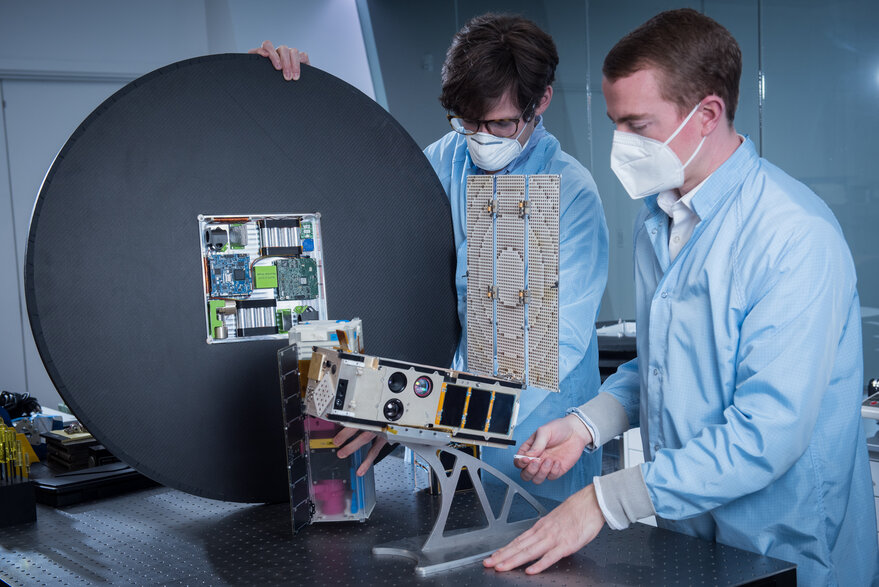SAN FRANCISCO – NASA approved a demonstration flight for DiskSat, the thin round satellite designed by the Aerospace Corp.
Aerospace Corp. engineers are building four DiskSats and a DiskSat dispenser, which they plan to send to low-Earth orbit in 2024 to validate the technology.
“People ask me, ‘Can you really fly that? Can you keep it under attitude control?’” Richard Welle, DiskSat inventor and senior scientist in Aerospace’s Mission Systems Engineering Division, told SpaceNews. “It’s a very ungainly vehicle compared to other things that are traditionally flown. Can you do the thermal management so that you don’t melt yourself down by collecting all that solar power?”
One-meter-diameter DiskSats are 2.5-centimeters thick. With the extensive surface area for solar panels, DiskSats could provide about 60 to 80 watts for onboard electronics. A DiskSat with a rigid deployable solar panel provides average onboard power of 100 to 160 watts.
Much of the power is likely to be harnessed for propulsion. During the demonstration mission, Aerospace plans to fly DiskSats in very low Earth orbit.
One pair of DiskSats, deployed from a rocket at an altitude of roughly 500 kilometers, will maneuver down to a 250-kilometer orbit. With propulsion to fight drag, mission planners intend to keep the DiskSats at that altitude for more than a week before moving it to a higher orbit.
The second pair of DiskSats will fly in an eccentric orbit with a perigee below 200 kilometers.
“The propulsion system has enough thrust to offset the drag down to about 230 kilometers in a circular orbit,” Welle said. “But in elliptical orbit, you can go lower provided you have time at higher altitude to do the drag makeup.”
In late April, Aerospace began the 18-month development campaign for the DiskSat demonstration mission. No launch vehicle has been identified yet.
At the Small Satellite Conference at Utah State University in August, Aerospace plans to display a DiskSat model.
“We’ll be happy to talk to anybody that’s interested in flying a DiskSat,” Welle said. “We’re planning to develop a DiskSat standard, analogous to the cubesat standard. We’ll define the interface between the satellite and launch vehicle with the idea that it can be used in rideshare operations.”
Aerospace engineers are developing a dispenser to release the circular spacecraft.
“In the long run, you may have flights with 20 DiskSats in a single dispenser,” Welle said. “We’re developing a dispensing mechanism that will release them one at a time with some reasonable time in between to ensure separation between adjacent disks in the stack.”
Welle sees key advantages to circular DiskSats compared with cubesats.
In terms of power, an eight-kilogram DiskSat with a deployable panel can easily provide 100 watts of onboard average power. To provide the same power, a cubesat with deployable panels would weigh approximately 30 kilograms, Welle said.
With higher power and lower mass than cubesats, DiskSats could employ electric propulsion to change their orbits dramatically. A 10-kilogram DiskSat could move, for example, from low-Earth to geosynchronous or even lunar orbit.
In addition, a DiskSat’s 2.5-centimeter edge would encounter little atmospheric drag, which is why the miniature satellites could operate at low altitudes. There’s growing interest in very low orbits where sensors can gather high-resolution Earth imagery.
“Operating DiskSats below 300 kilometers is straightforward,” Welle said. “That gives you a whole new orbital regime that is not overpopulated by other satellites.”
DiskSats are lightweight composite structures with hollow interiors. Components can be distributed throughout the internal volume or clustered in a central avionics bay.
“There’s a lot of volume that is spread out and easily accessible,” Welle said. “It greatly simplifies the manufacturing process.”
In addition, DiskSats in low Earth orbit are likely to reenter Earth’s atmosphere quickly once their missions end. Without attitude control, a DiskSat in a 600-kilometer orbit will reenter the atmosphere about two and a half years.
“If the attitude control system fails, the satellite tumbles,” Welle said. “That will increase the drag by an order of magnitude.”
